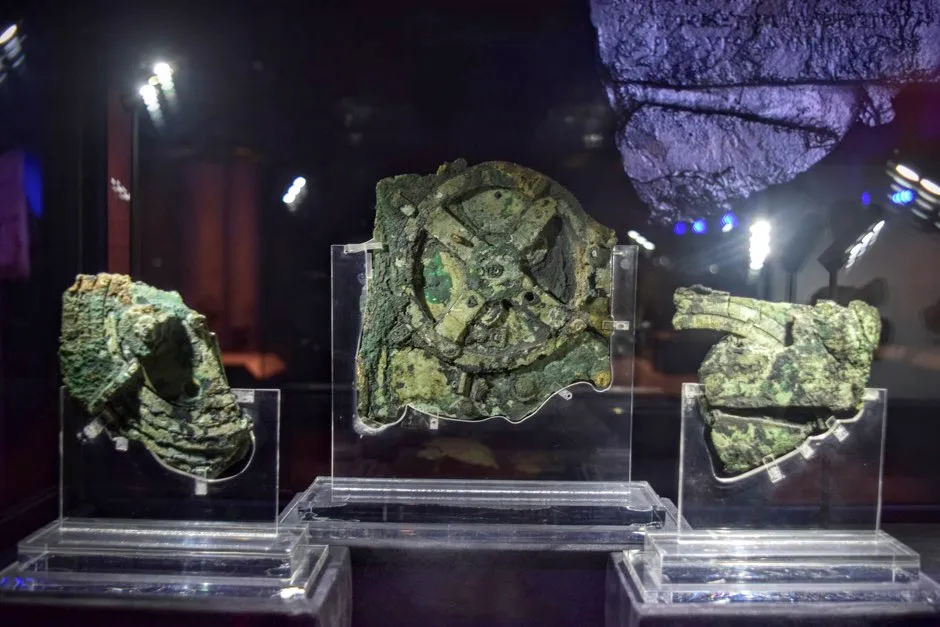Imagine, in an age long before miniaturised electronics, a portable machine, the size and shape of a shoebox, that showed a moving picture of the cosmos, with the Sun, the Moon, and the planets orbiting at greatly accelerated speed, so that with a few twists of a knob, you could see where they would be in the sky on some chosen date years in the future or past. It sounds like something in a fantasy story, but the mysterious Antikythera Mechanism shows that these devices were indeed being built, over 2,000 years ago.
Exquisite devices like this were being crafted in a Greek workshop somewhere in the eastern Mediterranean about 2,100 years ago or more. One of them met an unfortunate accident—for its owner, anyway, but fortunate for us since from its shattered remains we can learn a great deal about ancient Greek science and its public face.
The accident happened around 60 BC, off the island of Antikythera in the straits between Crete and the Peloponnese: a ship laden with bronze and marble statuary and other luxury objects, en route from the Aegean Sea to destinations in the western Mediterranean, was violently wrecked.
A team of Greek sponge divers discovered the shipwreck in 1900, and over the next year they salvaged what they could under the Greek government's supervision. Among the last items that the divers brought up were a few apparently nondescript pieces of corroded bronze, totalling less than a kilogram, which were to lie disregarded for months, together with other unidentified metallic fragments from the wreck, in a storage room of the National Archaeological Museum in Athens, until a chance visitor to the museum noticed toothed gears and inscribed Greek writing on them.

No comparable device from Greco-Roman antiquity had previously come to light, and for a while debate raged about what kind of instrument it was. One or two barely legible words inscribed on one fragment suggested some connection with astronomy, but beyond that, the archaeologists and other scholars who inspected it could not agree on its nature and purpose, or whether it was a navigational tool or part of the ship's cargo.
Almost forgotten, it sat in a display case for some years, and in the museum's storage for more. Then from the 1950s through the 1970s the Anglo-American historian of science Derek de Solla Price, recognising that it must be something of unique historical importance, established a framework for studying the Antikythera Mechanism (as he called it, and as it has been known ever since) that has gradually revealed it to be the most complex, information-rich artefact of Greek technology and science that we possess.
Price realised that the fragments, damaged and incomplete as they are, nevertheless preserve most of their mechanical components in their original arrangement, so that by close study of them combined with information derived from the inscribed texts, one might obtain at least a partial knowledge of both the exterior and the internal workings.
By now it was clear that the Antikythera Mechanism, when intact, was a box with wooden top, bottom, and sides framing bronze plates on the front and back faces; these plates bore several dials, and pointers on the dials indicated temporal cycles and periodically recurring astronomical phenomena. All was driven by an input motion through a revolving shaft on the box's side, representing the passage of time.

But since many components were concealed inside the fragments, radiography would be essential to complete the project of reconstruction. With the collaboration of a Greek physicist, Haralambos Karakalos, Price obtained X-ray radiographs of the main fragments, on the basis of which he attempted to work out what each dial displayed and what system of gears drove its pointer.
Our present understanding of the Antikythera Mechanism is much more complete and secure than Price's, thanks to campaigns of examination and data-gathering by Michael T. Wright and Allan Bromley in the 1990s and by the Antikythera Mechanism Research Project (AMRP) in 2005. Wright and Bromley found ways to extract three-dimensional information about the fragments' interiors from X-ray radiographs, while the AMRP obtained high-resolution X-ray computed tomography as well as reflectance transformation imaging (RTI).
The new data yielded much better imaging of gears, dials, and other physical features as well as of the texts inscribed on and around the dials—materials that have now been exploited by researchers from a range of disciplines, including astronomy and mathematics, history of science, and classics, to correct and complete Price's reconstruction.
Read more about science history:
What, then, was the Antikythera Mechanism? One way to think about it is as a kind of dynamic visual guide to astronomy for the lay person—astronomy, that is, as a Greek intellectual would have understood it around 100 BC.
We can start by considering the back face, which bore two large dials featuring spiral slots and variable-radius pointers ending in pins that rode along the slots. These spirals were a way of stretching out a dial's scale to make room for inscribing a lot of information along it.
For example, the upper spiral makes five turns, and the scale that runs along the outside of the slot is divided into 235 cells, each of which is just big enough to contain the required text. Instead of having the pointer go once around in the cycle represented by the dial, the gearwork was arranged to make the pointer go five times around, and when the pin reached the end of the slot, the operator would have to reset it to the beginning manually.
This dial represented the calendar used in a particular locality, identifiable as one of the cities of the region of northwest Greece called Epirus. The ancient Greeks had many regional calendars, but all had in common that the months were approximately coordinated with the Moon's phases. Years sometimes comprised twelve months but sometimes thirteen so that specific months always fell at roughly the same seasons.

The fifth century BC astronomer Meton of Athens had proposed a repeating 19-year cycle (which was also known in ancient Babylonia and China) in which eleven of the years had twelve months and eight years had thirteen, for a total of 235. On the Mechanism, the "Metonic Dial" marked just where each month and year of this cycle started and ended, and which months had 29 or 30 days. To complement this display of local practical astronomy, a small dial inset in the spiral counted off the years in the four-year cycle that regulated athletic festivals such as the Olympic Games that were honoured across the entire Greek world.
If the upper spiral of the back face represented a Sun-and-Moon cycle whose significance was social, the lower spiral's cycle governed spectacular phenomena involving the Sun and Moon that were widely believed to be signs from which one could forecast events affecting regions and peoples, namely eclipses.
Read more about great inventions:
For centuries, Greek astronomers had explained lunar eclipses as caused by the Moon's entering the Earth shadow, and solar eclipses as caused by the Moon's shadow falling upon the Earth, but the Mechanism did not attempt to show these optical conditions, but just the fact that conditions that make eclipses possible recur approximately after 223 lunar months (a period now called the Saros). Hence the scale of the "Saros Dial" was divided into 223 cells, some of which contained highly abbreviated statements that a lunar eclipse or a solar eclipse or both might take place during the indicated month—vacant cells signified eclipse-free months.
Turning from the back to the front face would have taken the spectator from cycles of time to cosmology in motion. The single front dial combined two perspectives on the system of heavenly bodies, showing where the sun, moon, and planets appear to be at any date by means of pointers along a scale representing the zodiac and subdivided into 360 degrees, while at the same time offering a simplified cross-section image of the cosmos as if seen from outside.

The cosmology was geocentric, with the Earth enclosed by a series of nested spherical shells belonging, in order of increasing distance, to the Moon, Mercury, Venus, the Sun, Mars, Jupiter, Saturn, and the stars. On the dial, these seem to have been portrayed as ring-shaped spaces between engraved concentric circles, and the heavenly bodies themselves as little spherical attachments to the pointers, each with a distinguishing material and colour.
The apparent motions of the heavenly bodies through the zodiac vary in speed and (in the case of the planets) periodically reverse direction. To reproduce the effect of nonuniform motion mechanically required special devices involving a pin attached to a revolving gear while sliding back and forth in the perforation of a slotted arm or gear. Such a pin-and-slot device for the Moon survives in the largest fragment, but the gearwork for the planets is mostly or entirely lost.
Instruments like the Antikythera Mechanism that employed high-end technology and metalworking to visualise the complexities of science were probably rarities in the Greco-Roman world, and most would have had their metal recycled when they stopped working and were no longer wanted. We are lucky to have this one, saved by an ancient calamity.
A Portable Cosmos: Revealing the Antikythera Mechanism, Scientific Wonder of the Ancient World by Alexander Jones is out now (£16.99, Oxford University Press)
Follow Science Focus onTwitter,Facebook, Instagramand Flipboard

